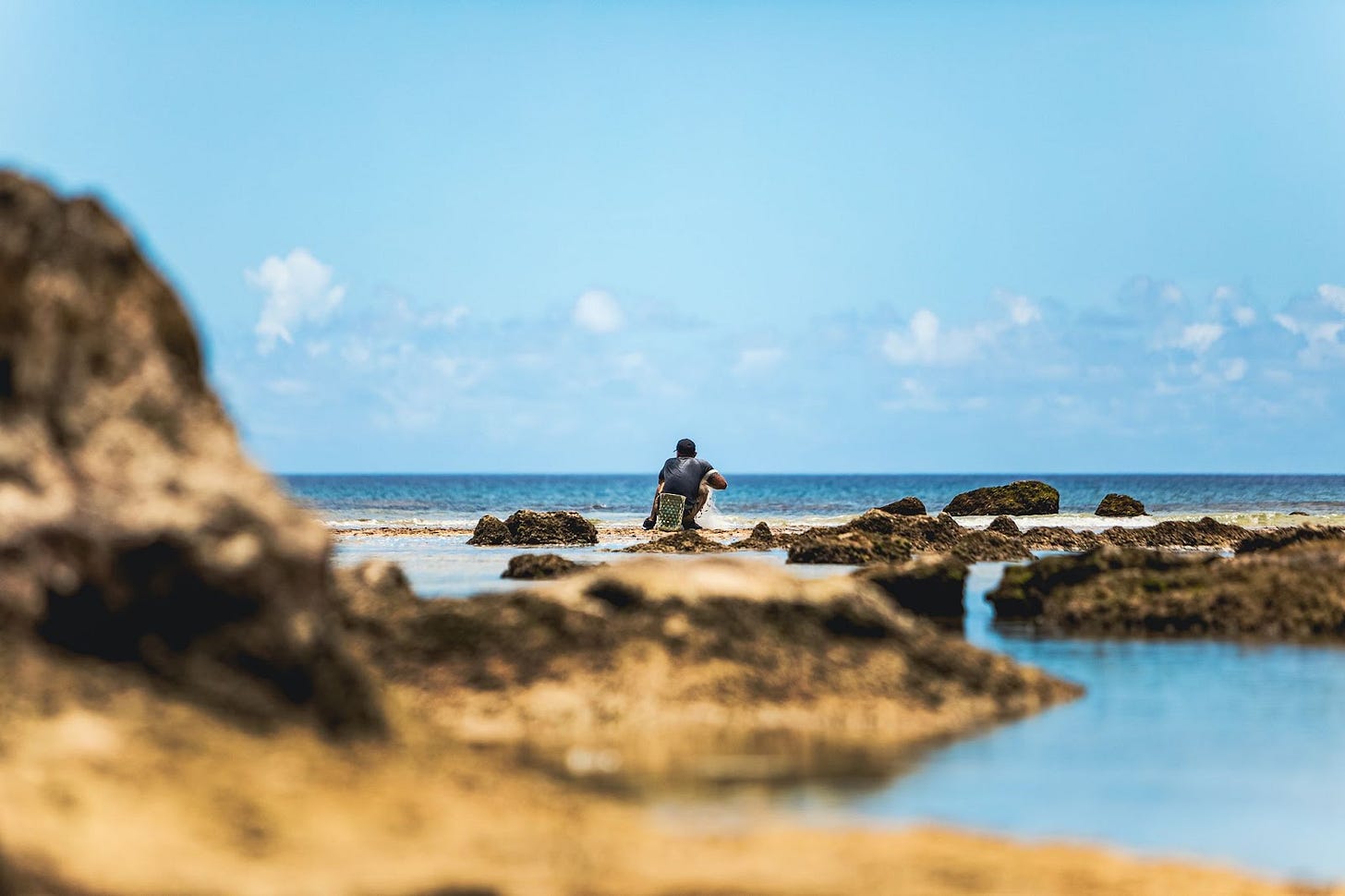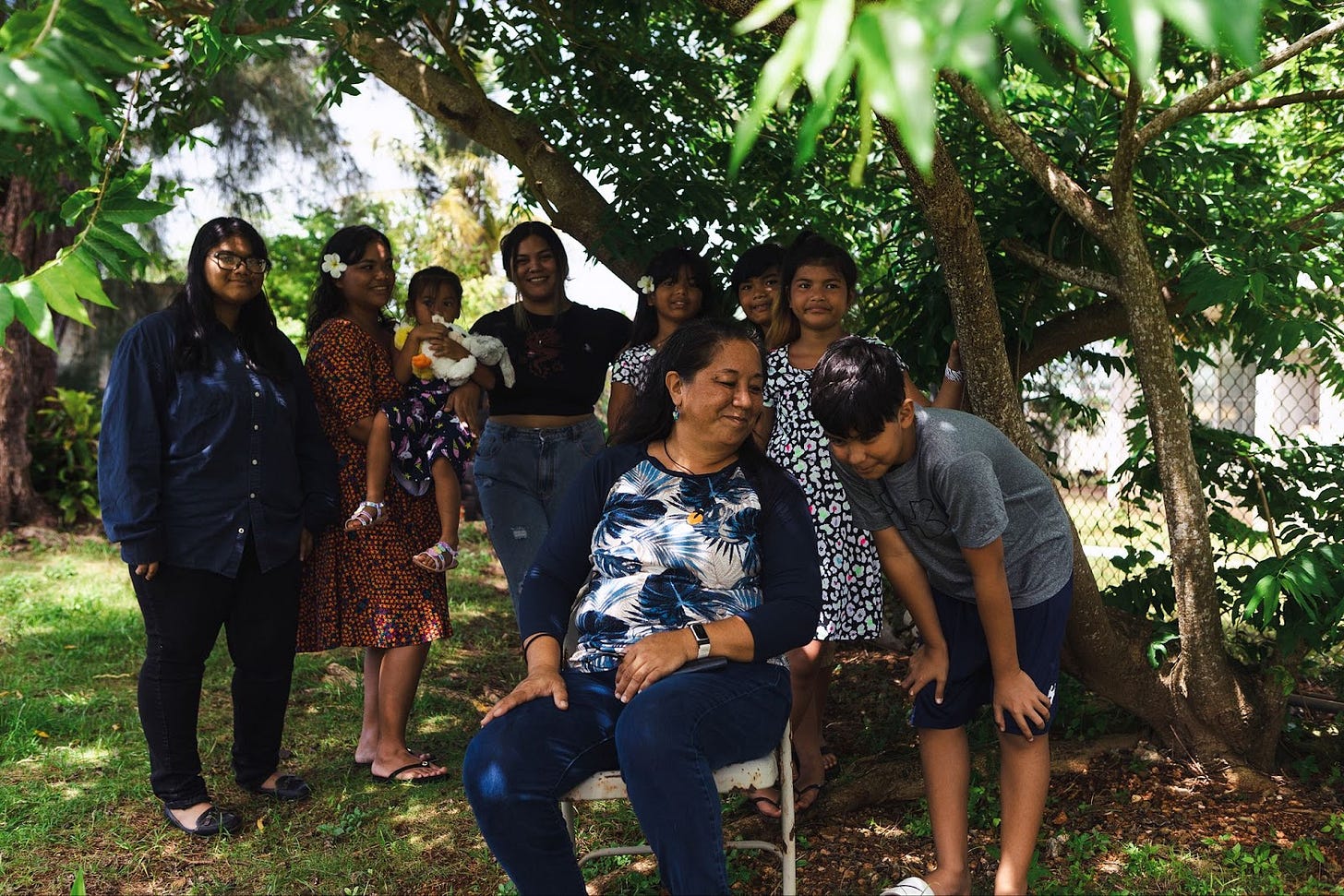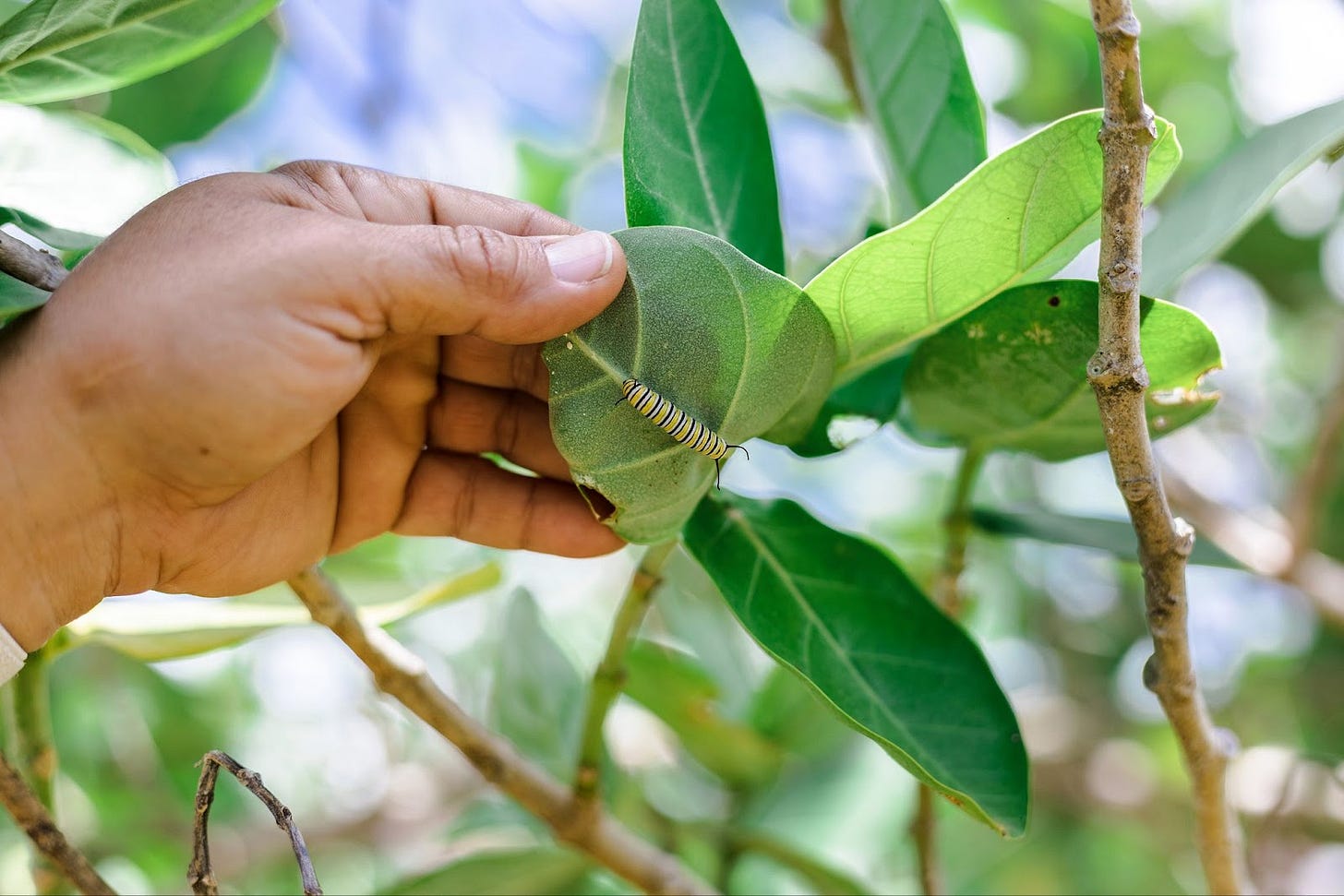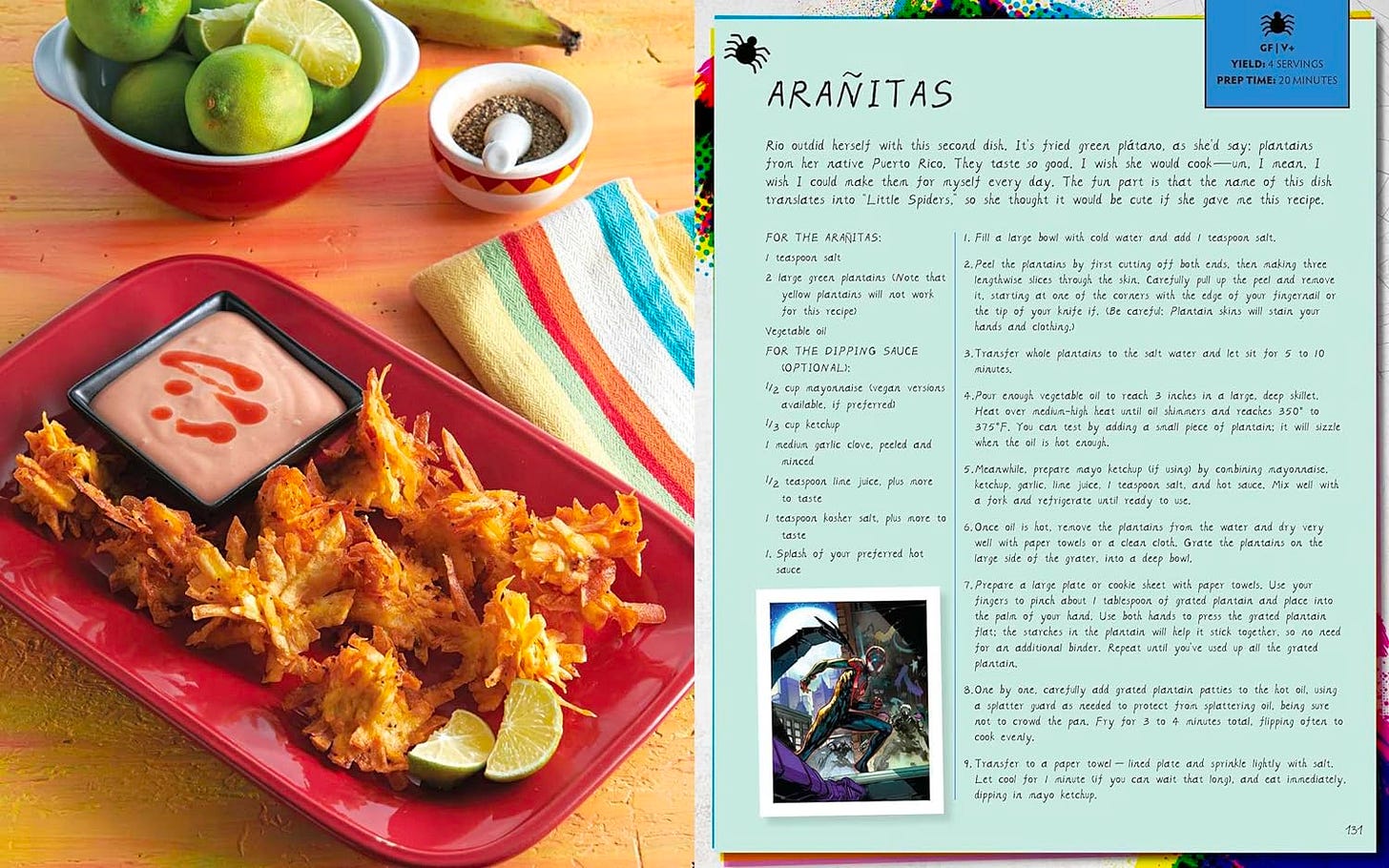Documenting Guam
Photographer Cami D. Egurrola, and ‘Islas’ is one of Esquire’s Best Cookbooks of 2024
Del escritorio de Von:
I’ve been on the road, so the Islas Audio Companion remains on hold. Stay tuned! But this week I’m celebrating one of the amazing AAPI photographers from Islas. Cami D. Egurrola is CHamoru—the indigenous people of the Mariana Islands, an environmental fellow at the Tishman Center, and the Director of Communications for the Micronesia Climate Alliance. For Islas, she captured stunning landscapes from her home in Guam, as well as portraits of Juanita Blaz—a local activist focused on women and girls. This guest post comes from Sophia Ramirez, Islas contributor and La Piña’s Social Media Coordinator.
De corazón,
Von
Some of the most striking images in Islas—a fisherman waiting in the tide, Juanita Blaz leading her community in a literal step forward— are the work of Guåhan (also known as Guam) based photographer Cami Diaz Egurrola. In addition to her photography, Cami is an activist and leader, working as the Director of Communications for the Micronesia Climate Alliance and an environmental justice fellow at the Tishman Center.
I spoke with Cami about what was going through her mind when she was photographing for Islas. Cami was a good fit for the project, in part, because she’s a storyteller. Her lens grounds the complex, polarizing challenges faced by islanders in everyday moments.
“I took a photo of a talåyeru, which is a fisherman. It's quite far away, but you can see him in the low tide. A lot of our fishermen are really feeling the effects of climate change – certain species of fish are getting harder and harder to find. And he was there for about, I’d say five or six hours in that same spot.”
With a snap, her camera captured a real-time consequence of climate change—ocean acidification, rising sea levels, coral bleaching, and overfishing—on life in the Mariana Islands.
For context, Guåhan is an occupied U.S. territory while the Northern Mariana Islands are a republic. While Guåhan’s environmental challenges—including the pollution of their drinking water—are exacerbated by the large U.S. military presence, the effects of climate change are present throughout the archipelago.
Cami sees her photography as a means to unify islanders across the Mariana Islands through their shared cultural identity. She captures moments of struggle, yes, but she also elevates the ancestral wisdom and grassroots movements that represent a path forward. Take her portraits of Juanita, for example.
“Auntie Juanita Blaz is really an embodiment of the true moral value system that we have here: Inafa'maolek, which is like reciprocity and social harmony. She's a Maga'håga, which is like the leading female, the boss.”
My conversation with Cami was peppered with these CHamoru words; she’s attending classes to become fluent in the native language of the islands. At one point, she noted that the value system she sees reflected in Juanita’s work is manifested in the structure of their native language.
“There's this word, mo'na. And it's used when we refer to our ancestors, Taotamo'na, Taotao meaning people and mo’na being in front. The idea is that our ancestors are not behind us, they're in front of us. So the solutions to all of these problems, when we say that Indigenous-led solutions are the solutions to the climate crisis, we don't think they're behind us. We don't look back. We look in front for these solutions.”
If you’ve read Juanita’s profile in Islas, you know that this is what her organization, ‘Island Girl Power,’ is all about. Now, Cami herself is a part of grassroots efforts to reconnect CHamorus to their ancestral heritage.
Her two years as an environmental fellow at the Tishman Center culminated in an Åmot Walk, a healing practice rooted in traditional medicine. Cami expanded on the intention behind this practice via email:
“The effects of colonization, militarization and the climate crisis have real and deep impacts on the mindsets and livelihoods of our people. We believe our culture and ancestry is a source of strength that can empower our communities to engage in climate action and cultural preservation. Given the rising geopolitical tensions and hyper-militarization of our region compounded by climate change, we believe that collective prayer and intentions for peace are powerful. Our purpose is to provide an opportunity for our people to experience community, grow cultural knowledge, and deeply connect with land in order to bring this experience and build relationships with islands across the Marianas.”
Cami and her fellowship partners (Sheila, Mina, and Moñeka) sponsored flights and lodging for more than 25 ceremony holders, community leaders, and environmental justice activists from across the islands. This was a huge accomplishment; a 15-minute flight between islands would typically run you about $600 or more.
They held Åmot Walks on four islands: Guåhan, Saipan, Tinian, and Rota. Each one culminated in a feast featuring the given island’s specialty dish, prepared by community members. On Guåhan, vegetables from the Åmot garden were served alongside barbecued beef. CHamorus from Saipan dished up the baked goods and sweet treats they’re known for. Cami’s favorite meal, however, took place on Tinian. The island is known for their cattle, and the community marinated fresh beef with a locally revered hot pepper called Donne Sali. You can find a similar recipe in Islas.
“Between the ceremony and the traditional medicine walk itself, it gave our community members a sense of confidence in their cultural identity and an avenue to look at our traditional ecological knowledge systems as a way of indigenous excellence.”
Working on Islas further solidified Cami’s conviction that ancestral practices like these are not remnants of the past; they are the path forward.
“One thing that I really loved about this experience was that it was healing, to look at food as this way of sovereignty for people, to look at food as a way of power. And this relationship with food that we have is so empowering, especially when we have the knowledge or the tools or the opportunity to share it.”
Esquire says Islas is one of the Best Cookbooks of 2024 (So Far)
Islas is on another list, this time among the 10 books Esquire highlighted as the best cookbooks of this year. Check out what they said!
“Can a cookbook open your mind and spirit to cultures you may not have authentically appreciated, yet still make you want to try every recipe it offers? Von Diaz’s latest achieves just that, as she writes about not just one but several island cuisines and cultures, including those of Puerto Rico, Madagascar, Guam, and Vanuatu. Islas is a mash-up of cultures both distinct and connected, and this book, thoughtfully written with approachable, clear-to-follow recipes, is a delight and wonder. Seriously, I’ve stopped earmarking pages. I’ve never been inclined to Julie & Julia a book until now. I just want to make everything. Irresistible.”
Thanks to Alex Belth for this thoughtful review. Made me blush!
Where I’ll be
Even more events on the calendar!
Saturday, May 25 · 11 AM EST - Fearrington Village, NC
A book signing and conversation featuring Von Diaz with Lauren Vied Allen and Brigid Washington
Thursday, June 13 · 7 PM EST - Archestratus Books in Brooklyn, NY
Book signing and conversation.
Saturday, June 15 · 10 AM - New York Botanical Garden, Bronx, NY
Opening Ceremony for the DIASPORA African American Garden at the New York Botanical Garden.
Friday, June 21-Sunday, June 23 - Cookbook Fest in Napa Valley
Book-signing, talks, and cooking over open fire.
Saturday, June 29 · 3 PM EST - A Capella in Atlanta, GA
Book signing and conversation.
Writer: Sophia Ramirez with Von Diaz | Editor: KC Hysmith
Un Poquito Mas …
I’m excited to announce another cookbook drop! Last year, the folks at Marvel (that’s right MARVEL!) and Insight Editions asked me to come up with a couple of recipes for the Spiderman: The Official Cookbook (available for pre-order, on sale July 2, 2024). They came to me because the incredible Miles Morales’ mom is Puerto Rican, and they wanted to honor his heritage. 🇵🇷 I reviewed the entire Miles Morales collection and developed two recipes, one for SPAM® Fried Rice, and the other for arañitas—a popular fried green plantain snack that resemble arañitas or little spiders.
Did you like this latest post of La Piña? Think someone else might like it, too? Please consider sending it to a friend or sign them up for a paid monthly gift subscription!













